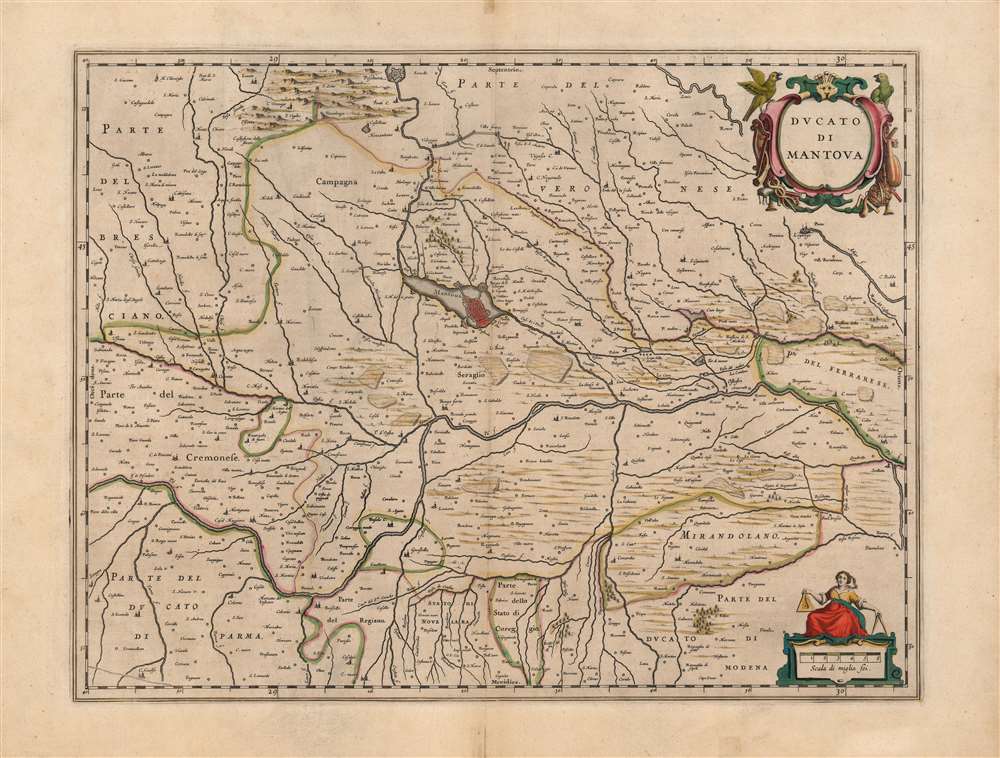1640 Blaeu Map of the Duchy of Mantua, Lombardy
Mantua-blaeu-1640
Title
1640 (undated) 15 x 19.5 in (38.1 x 49.53 cm) 1 : 270000
Description
The Cartouche
The elegant, strapwork cartouche is framed by musical instruments and astronomical tools. This may be an allusion to the long-standing patronage of the arts and sciences by the Gonzaga family, who ruled the Duchy from the fourteenth century. The cartouche is topped by a pair of parrots - not birds native to Italy. Their presence here may allude to Mantua's trade connections with Venice, which might have brought such exotic creatures to the city. These references, in the 1640s, can only have been flattering or nostalgic. The swarm of writers, artists, musicians, and actors enjoying Gonzaga patronage in the early seventeenth century - including for example Claudio Monteverdi - fled after the last Gonzaga (died 1627). Mantua was subsequently occupied by an Imperial army of 36,000 Landsknecht during the war of succession that followed. Along with the usual horrors of war attending this mercenary army, they also brought plague. By the time this map was printed, the population dropped from 40,000 in 1550 to 14,000.Publication History and Census
This map was engraved by Joan Blaeu for inclusion in the 1640 edition of the Atlas Novus. This example corresponds typographically to both the 1640 and 1644 Latin editions. It is well represented in institutional collections.CartographerS
Joan (Johannes) Blaeu (September 23, 1596 - December 21, 1673) was a Dutch cartographer active in the 17th century. Joan was the son of Willem Janszoon Blaeu, founder of the Blaeu firm. Like his father Willem, Johannes was born in Alkmaar, North Holland. He studied Law, attaining a doctorate, before moving to Amsterdam to join the family mapmaking business. In 1633, Willem arranged for Johannes to take over Hessel Gerritsz's position as the official chartmaker of the Dutch East India Company, although little is known of his work for that organization, which was by contract and oath secretive. What is known is his work supplying the fabulously wealthy VOC with charts was exceedingly profitable. Where other cartographers often fell into financial ruin, the Blaeu firm thrived. It was most likely those profits that allowed the firm to publish the Theatrum Orbis Terrarum, sive, Atlas Novus, their most significant and best-known publication. When Willem Blaeu died in 1638, Johannes, along with his brother Cornelius Blaeu (1616 - 1648) took over the management of the Blaeu firm. In 1662, Joan and Cornelius produced a vastly expanded and updated work, the Atlas Maior, whose handful of editions ranged from 9 to an astonishing 12 volumes. Under the brothers' capable management, the firm continued to prosper until the 1672 Great Amsterdam Fire destroyed their offices and most of their printing plates. Johannes Blaeu, witnessing the destruction of his life's work, died in despondence the following year. He is buried in the Dutch Reformist cemetery of Westerkerk. Johannes Blaeu was survived by his son, also Johannes but commonly called Joan II, who inherited the family's VOC contract, for whom he compiled maps until 1712. More by this mapmaker...
Giovanni Antonio Magini (June 13, 1555 - February 11, 1617) was an Italian astronomer, astrologer, cartographer, and mathematician. Born in Padua, he completed his studies in philosophy in Bologna in 1579. In 1588 he was chosen over Galileo Galilei as the chair of mathematics at the University of Bologna after the death of Egnatio Danti. Magini was a prolific writer, putting forth theories of celestial motion (he was a supporter of a geocentric solar system), the use of quadrants in surveying and astronomy, and trigonometry. In 1608, Magini produced the first map of Italy to improve on that of Gastaldi: his meticulously researched and beautifully engraved 8-sheet Italia Nuova was hugely influential: upon its publication, Blaeu promptly copied it to produce his own wall map of Italy; the rest of the mapmaking establishment swiftly followed suit. Consequently, virtually every 17th century map of Italy can be identified as a derivative of Magini's monumental achievement. His atlas, Atlante geografico d’Italia, was published posthumously by his son in 1620. This work was intended to include maps of every Italian region with exact nomenclature and historical notes. He also served as court astrologer for the Duke of Mantua. Learn More...

